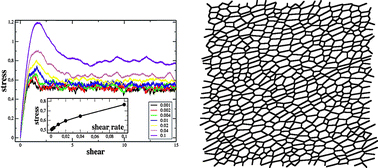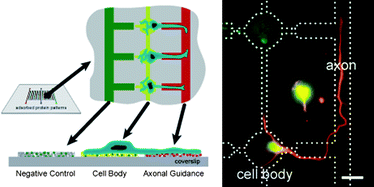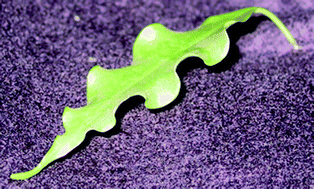ChemComm is delighted to invite nominations for the very first ChemComm Emerging Investigator Lectureship. The lectureship, which will be awarded annually, will recognise an emerging scientist in the early stages of their independent academic career. Deadline for nominations: 28th February 2011. Visit the ChemComm blog for more information.
Hot Article: Interaction of double-stranded DNA with a nanosphere: a coarse-grained molecular dynamics simulation study
In the tightly packed molecular world of the cell DNA is protected and wrapped up into small packages called chromatins. The complex plays a crucial role in living organisms because its dynamic organization is a key factor for controlling the regulation of gene expression.
To investigate the unwrapping process Qianqian Cao and coworkers at Jilin University, China, used coarse-grained molecular dynamics simulations to study the unwinding of a DNA-nanosphere complex when a force exerted on the DNA chain.
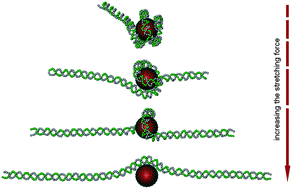
The team found that the wrapping degree and the folding state of DNA around the sphere is significantly dependent on the surface charge density and the salt concentration. When an external force is applied to two ends of DNA chain, different stages are observed in the stretching process as the complex is unwrapped. The team say that this behaviour also has been observed in experiments and other simulations on the stretching of chromatin.
Read Cao’s full article for free in Soft Matter here: Qianqian Cao, Chuncheng Zuo, Yanhong Ma, Lujuan Li and Zhou Zhang, Soft Matter, 2011, DOI:10.1039/C0SM00512F
Soft Matter Lectureship 2011: Nominations now open
Call for nominations
Soft Matter is pleased to announce that nominations are now being accepted for the Soft Matter Lectureship 2011. This annual lectureship was established by the journal in 2009 to honour a younger scientist who has made a significant contribution to the soft matter field.
Qualification
To be eligible for the Soft Matter Lectureship, the candidate should be in the earlier stages of their scientific career, typically within 15 years of attaining their doctorate or equivalent degree, and will have made a significant contribution to the field.
Description
The recipient of the lectureship will be asked to present a lecture three times, one of which will be located in the home country of the recipient. The Soft Matter Editorial Office will provide the sum of £1000 to the recipient for travel and accommodation costs.
The recipient will be presented with a certificate at one of the three lectures. They will also be asked to contribute a lead article to the journal and will have their work showcased on the back cover of the issue in which their article is published.
Selection
The recipient of the lectureship will be selected and endorsed by the Soft Matter Editorial Board.
Nominations
Those wishing to make a nomination should send details of the nominee, including a brief C.V. (no longer than 2 pages A4) together with a letter (no longer than 2 pages A4) supporting the nomination, to the Soft Matter Editorial Office by 18 February 2011. Self nomination is not permitted.
Top Ten most-read Soft Matter articles in September
The latest top ten most downloaded Soft Matter articles
See the most-read papers of September 2010 here:
DOI: 10.1039/C002231D
DOI: 10.1039/C0SM00043D
DOI: 10.1039/B919944F
DOI: 10.1039/B712575P
DOI: 10.1039/C0SM00411A
DOI: 10.1039/C000305K
DOI: 10.1039/B516741H
DOI: 10.1039/B509038E
DOI: 10.1039/B506092N
DOI: 10.1039/B517840A
Hot Article: Gibbs elasticity effect in foam shear flows: a non quasi-static 2D numerical simulation
Have you ever wondered what’s going on in a foam when it flows? In her latest Soft Matter paper, Isabelle Cantat at the Université Rennes, France, simulates the dissipation of bubbles in foam. Cantat used 2D numerical simulations involving 500 bubbles under simple shear, in a non-quasi static regime to study the dissipation of bubbles.
Cantat shows that small tension dynamical inhomogeneities induce foam structure modifications responsible for the largest part of the stress increase. The stress increase with increasing shear rate is mainly due to increasing bubble elongation that can be interpreted as an increase of the plastic threshold.
Interested to know more? Read Cantat’s Soft Matter paper here:
Hot Article: Driving bioenergetic processes with electrodes
UK Scientists have created a hybrid system that uses non-biological energy to drive biological processes. Harnessing non-biological energy to power biological processes offers a convenient method to rapidly turn on and off biochemical reactions and the technology could be useful in many bioengineering applications.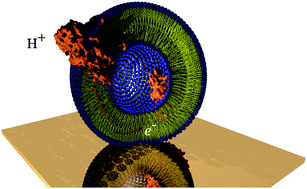
Led by Lars Jeuken researchers at University of Leeds, UK, used a gold electrode to drive the removal of protons from lipid vesicles adsorbed onto the electrode’s surface. The system uses the electrode to reduce ubiquinone in the vesicles. Protons are then pumped across the lipid bilayer and out of the vesicle by an enzyme (ubiquinol oxidase) which re-oxidises the ubiquinone. Actively pumping protons out of the vesicle creates a proton gradient between the vesicle’s interior and the surroundings which the team detected using a fluorescent probe.
The team says that this technology could open a way to use the pH gradient to drive other reactions such as active transport of organic substrates across the membrane or ATP synthesis.
Read the full article for free here:
Don’t forget you can also follow Soft Matter on Twitter to keep up to date with all the latest news!
Hot Article: Vacuum soft lithography to direct neuronal polarization
A simple method for simultaneously patterning different biomolecules on a surface can create complex patterns in a single step. These patterns can direct the adhesion, polarization, and guide neurites in neurons. The technique called vacuum soft lithography was developed by a team led by Sarah Heilshorn, University of California, Berkeley, USA, and could be used in to prepared surfaces for use in tissue engineering or translational medicine the team say.
To create the complex patterns, biomolecules are physically adsorbed onto glass slides using a removable polydimethylsiloxane microfluidic template. The method uses the gas permeability of PDMS to fill circuitous and dead-end microfluidic channels. Upon removal from vacuum, degassed PDMS templates store a negative pressure relative to atmosphere which can be used to pull solutions through closed microfluidic channels. The technique is capable of preparing designs with better than 2 µm resolution.
Interested to know more? Read the full article here: J. Tanner Nevill, Alexander Mo, Branden J. Cord, Theo D. Palmer, Mu-ming Poo, Luke P. Lee and Sarah C. Heilshorn, Soft Matter, 2011, DOI:10.1039/C0SM00869A
Hot Article: Grabbing water
Inspired by floating flowers, a passive pipetting mechanism allows for water to be grabbed with a flexible solid.
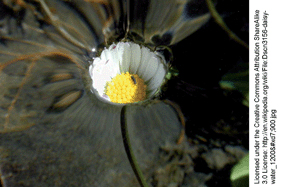 The technique was developed by a team led by Pedro Reis at Massachusetts Institute of Technology, USA, and co-workers in USA and France. The passive pipetting mechanism relies purely on the coupling of the elasticity of thin plates and the hydrodynamic forces at the liquid interface. By developing a theoretical model the team were able to design petal-shaped objects with maximum grabbing capacity.
The technique was developed by a team led by Pedro Reis at Massachusetts Institute of Technology, USA, and co-workers in USA and France. The passive pipetting mechanism relies purely on the coupling of the elasticity of thin plates and the hydrodynamic forces at the liquid interface. By developing a theoretical model the team were able to design petal-shaped objects with maximum grabbing capacity.
Interested to know more? Read the full paper here: Pedro M. Reis, Jérémy Hure, Sungwan Jung, John W. M. Bush and Christophe Clanet, Soft Matter, 2010, DOI:10.1039/C0SM00895H
Soft Matter issue 21 is online now!
The outside front cover features a review on Imaging and manipulation of single viruses by atomic force microscopy written by M. Baclayon, G. J. L. Wuite and W. H. Roos, Vrije Universiteit, Amsterdam, The Netherlands.
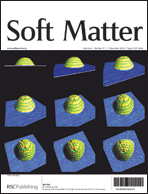
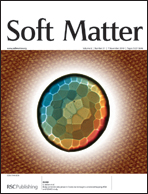
The paper featured on the inside front cover is Body-centered cubic phase in 3-arm star mesogens: a torsional tapping AFM and GISAXS study by Goran Ungar and co-workers at University of Sheffield, UK, Seoul National University, South Korea, and Chemnitz University of Technology, Germany.
The issue also includes a mammoth 5 Hot Articles:
- Light and temperature bi-responsive emulsion foams
- Heterogeneity of the electrostatic repulsion between colloids at the oil–water interface
- Lipid bilayers on topochemically structured planar colloidal crystals: a versatile platform for optical recording of membrane-mediated ion transport
- Characterisation and performance of hydrogel tissue scaffolds
- The characterisation of polygalacturonic acid-based layer-by-layer deposited films using a quartz crystal microbalance with dissipation monitoring, a dual polarization interferometer and a Fourier-transform infrared spectrometer in attenuated total reflectance mode
Read the full issue here: Soft Matter issue 21, 2010
Hot Article: The mechanics of non-Euclidean plates
Eran Sharon and Efi Efrati from The Hebrew University of Jerusalem, Israel, discuss the mechanics of non-Euclidean plates in a Tutorial Review. Non-Euclidean plates are “stacks” of identical surfaces whose two-dimensional intrinsic geometry cannot be realized in a flat configuration. They can be generated via different mechanisms, such as plastic deformation, natural growth or differential swelling.
The review covers theoretical and experimental works that focus on shape selection in non-Euclidean plates and provides an overview of the governing principles of this field.











